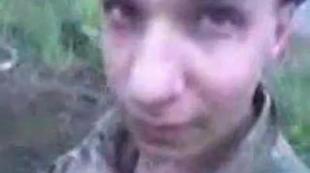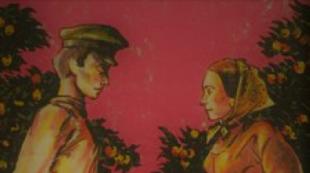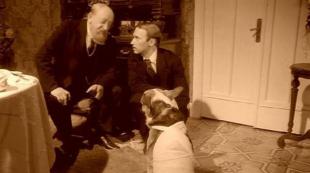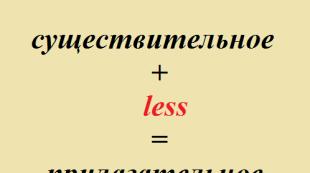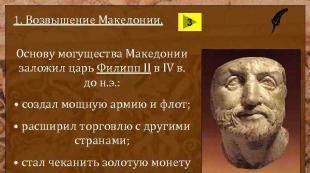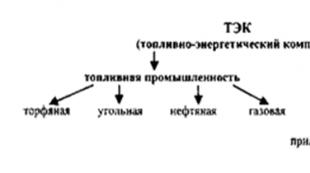Open lesson on the topic "school". Song about school in English Children's tasks on the topic school
Today I would like to present to your attention my song about school on English language. school years the most important time in the life of a child, since at this time the foundation is laid for the further successful comprehensive development of a person. Along with academic knowledge, the child learns to cooperate in a team, to be polite, responsible, attentive to others.
My song called "School Song" talks about everyday school life, what children do in the classroom and what they need to take with them to school in order to study successfully.
Lyrics of a song about school
School Song
At school I read, at school I write,
At school I count, at school I laugh,
To school I go every day.
At school I learn, at school I play,
To school I go every day.
School, school, I go to school,
School, school, I go to school.
I take my pen, I take my book,
I take my bag, I take a look,
If I forget my things today
And learn and play.
If I forget my things today
I cannot read and write and count
And learn and play.
School, school, I go to school,
School, school, I go to school.
School, school, I like my school.
In addition to the song, I prepared two sets of flash cards on the topic "School" in English. The first set includes cards with pictures and words written on it, while the second set contains cards with only pictures and the words are given on separate small cards. You can use these cards for various vocabulary games in English lessons, such as “What is missing?” or “What do you have to take to school first of all?”
Set 1





Set 2





I also present to your attention a series assignments on the topic "School" in English. It should be noted that the tasks given not only the words from this song, but also other names school supplies, so before doing these tasks, make sure that your students know this vocabulary.
Exercise 1 : This is the simplest task that allows children to work out the skill of finding sound-letter correspondences. Children must determine which letter this or that object begins with, and connect the pictures with the corresponding letters.
Task 2 : In this task, children need to read the names of school supplies and match them with the corresponding picture.
Task 3 : This task allows you to firmly remember the spelling of English words on the topic “School supplies”. Children need to determine what the word is, insert the missing letter and connect with the corresponding picture.
Task 4 : This task corresponds to the lyrics of my song “School Song”. Children need to connect verbs that describe school activities with the corresponding picture.
Task 5 : This is a task to practice the spelling of words. Children should circle and independently write the verbs naming the activities in the lesson at school.
Task 6 : In this task of increased difficulty, children need to decipher the verbs that describe school activities and match them with the corresponding pictures.
I hope you enjoy my song about school, and you will be happy to sing it in English lessons.
Tasks for a child of 6-7 years old, aimed at express preparation for school: the study of a soft sign, types of lines and angles, the development of thinking and mental counting, the development of speech and attention.


Learning to read. Introduction to "b"
Target: the formation of reading skills, acquaintance with a new letter.
Material: worksheet. Card with b. Cards with the words - DUST and DUST, MOL and MOL.
In Russian there is a sign that denotes the softness of a consonant - a soft sign. A soft sign is not a sound.
The teacher shows a card with a soft sign.
- A soft sign is a special sign. A soft sign is just a signal to the mouth and tongue - to say SOUND differently.
- b almost always softens, like a pillow.
The teacher shows cards with the words:
Children circle the letter with a finger along the contour, "remember the letter."
What letter is written on the worksheets at the top left? (b).
- Write b with your finger in the air.
- Draw patterns on the letter b.
- Circle and complete your own b.
- What does b look like?
Learning to read. soft sign

Target: the formation of knowledge of the image of the letter.
Material: worksheet. Plasticine.
Let's make a soft plasticine sign.
Now listen to a poem about a soft sign:
Read the poem on your own. Learn it by heart at home.
Learning to read. Words with "b"
Target: the formation of reading skills.
Material: worksheet.
Read the words. Underline the b in the words.
Dictation. Offers
Target: the formation of writing skills, the development of coding ability.
Material: worksheet.
Write a sentence under dictation:
IN THE PARK ROS POPL.
Put stress on the words.
What is at the end of a sentence? Circle the dot.
Mathematics. Lace work. Repeating all kinds of lines and angles

Target: Consolidation of the concepts of "closed", "open", "straight", "curve" lines. Repetition of all types of angles (straight, acute, obtuse). Repetition of the days of the week. Fixing graphic images of numbers.
materials: each child - beads, a lace with a knot at one end. Three laces. Ball.
The teacher throws the ball to the children, asking questions and giving assignments:
- Count from 1 to 5.
- Count from 4 to 8.
- Count from 7 to 3.
- Name the neighbors of the number 5.
- Name the neighbors of the number 8.
- What are the lines? (Straight lines, curves, closed, open).
- What is a cut? (This is a piece of a line, part of a line).
- What are the corners? (Acute, straight, blunt).
- How many days are in one week? (Seven). Right! Now we will string beads on a string, like days for a week, and pronounce each day of the week in order.
The teacher distributes laces (with a knot at one end) and beads to the children and suggests, putting the beads on the lace, repeat the days of the week in order:
- Monday (children repeat "Monday" in chorus, putting the first bead on the string).
- Tuesday (put on the second bead, repeating the second day of the week in unison).
- Wednesday... Etc.
- Well done! Samodelkin sent each of you three shoelaces and wrote tasks. I will read and you will do:
1. Turn the first lace into a straight line (put a lace on the tables in the form of a straight line), turn the second lace into a curved open line (lay), and turn the third lace into a curved closed line. (They put it.) An adult checks who did not cope - draws answers on the board, reminding what a closed and open line is.
2. Second task: turn the first lace into an acute angle, the second into a right angle, and the third into an obtuse angle. (Children do. Then the adult draws on the board - the children check themselves).
3. Fold the first lace into an oval, the second into a triangle, the third into a circle.
4. Last task: fold the first lace into the number "1", the second into the number "6", and the third into the number "3". What letter does the number "3" look like?
Development of thinking. Game "What is superfluous?"
Goals: development logical thinking, systematization of ideas about the world, the development of the ability to group objects according to a common feature.
materials: Ball.
Children stand in a circle. The teacher throws the ball to each child in turn, calling 4 words. The task of the child is to name an extra word and explain his choice.
Word groups:
Mathematics. Verbal counting

Target: Counting within 10.
materials: each child - cards with numbers.
Listen to how many times I clap my hands, and hold up a card with a number greater than two. (The teacher claps his hands 5 times, the children must raise the card with the number "7").
Listen to how many times I stomp my foot, and hold up a card with a number less than two units. (The teacher stomps 7 times, the children raise the card with the number "5"). You can ask one of the guys to comment on their answer, helping him if necessary. The child says: "You clapped your hands 7 times, and the number that is less than seven by two units is five").
Well done! Now listen to how many times I hit the pen on the table, and raise the number greater by 1 unit. (Knocks the pen on the table 9 times, the children raise the number "10").
To make it harder for you to ask... Listen to how many times I ring the bell, and show the number less than three units. (Rings the bell 9 times, children show a card with the number "6").
Tasks can be simpler: listen to the claps and show a number equal to their number or more / less by 1 unit.
Mathematics. Introduction to the concept of "Cylinder"
Target: Count within 10. Introduction to the concept of "Cylinder".
materials for each child: Cards with numbers. For each table: A rubber turnip or a heavy object, a set of unsharpened pencils. For the teacher: cylindrical objects: sausage, pencils, jars, glue stick, etc.
The teacher puts cylindrical objects on the table: a glass, a sausage, a cylinder hat, a cylindrical jar, an adhesive pencil, etc.
- Guys, what do all these items have in common? (All of these items have a similar shape.)
If children find it difficult to answer, you can ask leading questions:
- Maybe the objects are made of the same material? Maybe they are the same color? Size? Forms? When the children answer the question, the adult summarizes:
- This shape is called a cylinder, and objects of this shape are called cylindrical. The word "cylinder" in ancient Greek meant a roller that could be rolled on the ground.
The teacher distributes cylinders to the children and offers to roll them on the table or on the floor. Children make sure that the cylinders roll.
- In the old days, when there were no cars and cranes, people moved heavy objects with the help of cylinders. So the grandfather and the woman, when they pulled out the turnip, realized that they themselves would not bring it home.
- We need cylinders! - said the grandfather.
- Where can we find them? Grandma was surprised.
- Let's cut down a few trees, take their trunks - and we get cylinders!
And so they did. They cut down several trees, cleared them of branches, and cylinders turned out. Imagine that pencils are peeled tree trunks. (Children receive a set of unsharpened round pencils ("tree trunks") and rubber turnips (or other "heavy" objects). Think about how you can use cylinders to move a Turnip or any other heavy load from one end of the table to the other?
Children express their suggestions, an adult helps to come to the idea that the Turnip is placed on top of the pencils, the pencils roll, moving a heavy object. The kids are trying it out.
Mathematics. Examples
Target: development of thinking operations.
Material: worksheet.
Fill in the missing characters to make the examples correct.
Development of attention Cups

Target: development of the properties of attention.
materials: worksheet, pencils.
Find all the cups in the picture.
How many cups did you find?
The development of speech. Writing options for the ending of a fairy tale
Target: development of thinking, speech, fantasy.
materials: No.
The teacher asks one of the children to tell the tale "Ryaba the Hen".
- Guys, are you sorry that the mouse broke the golden egg and upset the grandmother and grandfather? (Yes).(Answer options.) The teacher encourages children to fantasize with leading questions. If the children are silent, the adult himself begins to fantasize aloud, connecting the children to the discussion:
- Or maybe it could be different? The testicle might not have broken, do you think? (Could). Let's come up with a different ending for this tale - where the testicle did not break. How could this happen?
Options for continuing the story:
1. "... the mouse ran, waved its tail, the testicle fell, but did not break, because it had a strong shell and it fell on the straw. The grandfather and the woman realized that this testicle was not beating, went to the hen and said: take it , hen, my testicle back - we can’t do anything with it. The hen took her golden egg and brought out of it a chicken - not a simple one, but a golden one! The chicken grew by leaps and bounds, and soon became a golden cockerel that could grant wishes ... "
2. - And how else could this fairy tale end? "... The mouse ran, waved its tail, the egg fell and broke ... Then the hen laid them another golden egg. The old people took it, broke it, the grandmother kneaded the dough and baked Kolobok. And they sold the golden shells and bought a fur coat for the grandmother, and for the grandfather hat for the winter. Etc.
Then, summarizing:
- Guys, what ending did you like the most - the one that was or one of those that we came up with? Why?
Development of thinking. What is superfluous?
Target: development of mental actions of analysis-synthesis, generalization
1. Wolf, fox, bear, rabbit.
2. Lynx, wild boar, hare, elk.
3. Panther, leopard, tiger, bear.
4. Lion, buffalo, giraffe, donkey.
5. Wolf, hedgehog, eagle, fox.
Preparing the hand for writing. Cell copying. Dog
Target: development of grapho-motor functions.
Material: worksheet.
Copy the dog in the cells.
Drawing with paints. Bear

Target: development of graphics functions. Development of creative thinking, imagination, development of the basics of modeling, consolidation of ideas about geometric shapes (circle, oval, semicircle). Developing the ability to work with paints in the "sticking" technique.
materials: a sheet of paper, brown gouache paint, a brush, a glass of water, a napkin, a pencil, a finished sample.
- Let's draw a bear using only circles, ovals and semicircles in drawing.
- What should I draw on a bear? (Head, body, legs). Right, but how many paws does a bear have? (Four paws).
- Thank you. So, I draw on the board, and you draw on a piece of paper.
- First you need to draw a large vertical oval. It turned out the body of a bear.
- Then you need to paint a circle on top. The circle is his head.
- Then draw 4 ovals, which will be the paws of the bear.
- Now let's take care of the head. On top of the circle, draw two semicircles - it turned out ... (Ears!)
- Draw a horizontal oval inside the circle - the muzzle of the bear. Above the oval are three circles: the bear's nose and eyes. And in the oval itself we draw a semicircle - we get a clubfoot mouth.
Then draw the claws on the paws and take brown paint.
- To depict the fur of a bear, you need to put the paint with pokes.
- The drawing of the bear is ready!
The teacher asks homework children.


Natalya Bazhitova
The task of the speech therapist to the educator of the speech therapy preparatory group for school on the lexical topic "School supplies"
September - 1 week.
Theme of the week: "Hello Kindergarten".
Lexical topic : "Knowledge Day" (School, school supplies.) .
(preschool group.)
Program content: activate in speech words related to topic« School» ; familiarize children with school supplies, teach them to compare, generalize objects and highlight characteristic features; study the professions of employees schools.
Enter into active speech.
Nouns: school, school desk, September 1, knapsack, notebook, textbook, pen, pencil, album, ruler, eraser, paints, board, pencil case, pointer, chalk, etc.
adjectives:
Verbs:
Group tasks.
1. Articulation gymnastics : complex №1.
2. Finger gymnastics: complex №1.
3. Breathing exercises: complex №1.
4. Gross motor skills (physical minute).
School.
I step into the first class - this time.
(Walking in place.)
The green around the grass is two.
(Hands bent at the elbows, alternately spread your arms away from you to the sides.)
You look at the form - it's three.
(Run back of hand from shoulder down.)
And four is fine.
(Move your right hand forward, raising your thumb up
Five - did not forget to take anything.
(Tap on the sides with your hands.)
Six - there are pens and notebooks.
(Bend the fingers of the left hand with the right hand.)
Family schoolboy at all.
(Right hand touches the chest with the palm.)
Eight - let's discard laziness.
(Hands move away from you.)
Nine - to believe in the best.
(Hands up, eyes up.)
Ten - September is a great month.
(Hands apart.)
5. Tasks on the development of phonetic and phonemic hearing and perception.
A game "Hear and Clap".
Game progress. An adult pronounces a series of words, a child with closed eyes, having heard a word for a given topic clapping his hands.
6. Tasks for the development of vocabulary- the grammatical structure of speech.
7. Tasks for the development of coherent speech.
Sources:
1. Internet.
2. Teach me to speak correctly! A comprehensive methodology for preparing a child for school. - St. Petersburg: Publishing House "Litera", 2015. 208 p.: ill. – (Series "Lessons speech therapist» ).
Related publications:
Homework for children of the senior group on the lexical topic "Professions at a construction site" TOPIC "Professions at the construction site." 1. Words to expand vocabulary: profession, work, construction, architect, engineer, builder, worker,.
Homework for children of the senior group on the lexical topic "Spring" TOPIC "Spring" 1. Words to expand vocabulary: spring, thaw, sun, cloud, icicle, drops, thawed patch, willow, puddle, stream,.
Homework for children of the senior group on the lexical topic "Indoor plants" TOPIC "Indoor plants" 1. Words to expand vocabulary: plant, cactus, rosan, crassula, saxifrage, coleus, clivia, geranium,.
Homework on the lexical topic “Professions. Seamstress" THEME “Professions. Seamstress 1. Words to expand vocabulary: profession, work, atelier, factory, seamstress, dressmaker, clothes, fabric, button,.
From the experience of working with older preschoolers of a speech therapy group on the lexical topic "Pets" From the experience of working with older preschoolers of a speech therapy group on the lexical topic "Pets". During the preliminary work on
Synopsis of a speech therapy lesson in the preparatory group "School supplies" Topic: "School supplies" Purpose: to expand and activate the vocabulary on the topic under study; systematize knowledge on the topic; exercise.
Svetlana Glushchenko
Material on working with children on the lexical topic “School. School supplies»
Subject Dictionary: Class, school desk, board, lesson, schedule, subjects, mathematics, writing, reading, drawing, physical education, form, student, student, chalk, teacher, head teacher, director, textbooks, pencil case, pen, pencils, notebook, album, brush, paints, eraser, cardboard, paper, ruler , plasticine, glue, scissors, score, pupils, call, change.
Verb Dictionary: Learn, try, listen, cook, teach, receive, write, count, decide, draw, clean, relax.
Feature Dictionary: Younger, older, diligent, assiduous, neat, attentive, preparatory, first, good, bad, mischievous, funny, smart
finger game "Change".
Change! Change! Rhythmic clenching-unclenching of the fists on both hands.
Have a good rest: Movements with relaxed hands up and down.
You can run and make noise
Dance and sing songs
Alternate flexion of the fingers of both hands into fists.
You can sit down and be silent, Fingers form "lock".
Only - churn! - you can not be bored! Movement with the index fingers of both hands to the right and left.
Improvisation of movements in accordance with the text.
"IN school» .
Soon in we will go to school,
And take a briefcase with you.
Let's write by hand.
engage in physical education,
On "Great" everyone try!
A game "Giants - gnomes"
Goals: to form the grammatical structure of speech, to teach the use of diminutive suffixes.
Game progress. The teacher informs the children that everyone goes to school. Gnomes and giants also went to school.
For example:
Giants have large briefcases, and gnomes have small briefcases.
Giants have big books, and gnomes have small books.
The giants have large pencils, and the gnomes have small ones.
The giants have large notebooks, and the gnomes have small ones.
Giants have large rulers, and gnomes have small ones.
Giants have big hands, while gnomes have small ones.
Giants have large hands, while gnomes have small ones.
"Fix the offer"- learn how to compose correctly offer:
Lena to go school.
Briefcase Natasha carry.
The boy is learning to answer.
Girl don't walk school in.
A game "How?"
Goals: to form the grammatical structure of speech, to learn to form adverbs from adjectives
Game progress. The teacher invites the children to complete the sentences by answering the question "How?"
The boy is a good student, he studies (How). (Fine).
Attentive the girl is always listening (How). (attentively) .
Diligent students always do their homework (How). (carefully).
Diligent children study (How). (diligently).
The one who gets excellent grades learns (How). (Great).
A game "Say the opposite"
Goals: enrich vocabulary, learn to select antonyms.
Game progress. The teacher invites the children to continue the sentences with the opposite words.
Masha is a neat girl, and Sasha is. (sloppy).
Lida is a diligent student, and Katya is. [lazy).
Zhenya is fat, and Lena is. (skinny).
Vitya is strong, and Roma is. (weak).
Kolya is brave, and Kostya is. (cowardly).
Dasha studies well, and Oleg -. (Badly).
Olesya has a new portfolio, and Ira has one. (old).
A game "Family"
Goals: enrich vocabulary, learn to select single-root words for a given one.
Game progress. The teacher invites the children to find the given words of relatives.
Words: school, book, teach.
A game "Collect the Word"
Goals: develop visual attention, improve reading skills and sound analysis of words.
Game progress. The assignment is done in notebooks. The teacher invites the children to follow where the arrow leads, and
put the letters in their places. Children read what word they got and perform its sound analysis.
Goals: develop auditory attention, thinking, teach a coherent monologue statement (interpretation of the riddle).
Game progress. The teacher guesses a riddle, the children guess. One of the guys explains its meaning. The rest are complementary.
Black Ivashka -
wooden shirt,
Where the nose leads
Puts a note there.
(Pencil)
A. Rozhdestvenskaya
What is this animal
Walks up and down?
Painted nose,
Wooden long tail.
(Tassel)
V. Danko
Baby birds
sat in a row
And words are spoken. (Letters)
V. Fetisov
On the black field
Skok-jump-
A white bunny is walking. (Board had)
V. Kremnev
I am ready to reveal my secret to anyone,
But you won't hear a word from her.
(Book)
A. Kostakov
How boring, brothers,
Riding on someone else's back!
Who would give me a pair of legs,
I would dance like this.
But I can't, I school. (satchel).
Text to retell
BLUE LEAVES
Katya had two green pencils. Lena has none.
So Lena asks Katya:
Give me a green pencil!
And Katya says:
I'll ask my mom.
Both girls come in the next day school. asks
Lena:
Did mom let you?
Katya sighed and said:
Mom allowed me, but I didn’t ask my brother.
Well, did your brother let you? Lena asks the next day.
My brother allowed me, but I'm afraid you'll break your pencil.
I'm careful, - says Lena.
Look, - says Katya, - don't fix it, don't press hard.
Lena looked at her and walked away. I didn't take a pencil. Katya was surprised and ran after her.
Well, what are you? Take it!
No, Lena replies.
In class, the teacher asks:
Why do you, Lenochka, have blue leaves on the trees?
No green pencil.
Why didn't you take it from your girlfriend?
Lena is silent. Katya blushed and speaks:
I gave it to her, but she won't take it.
The teacher looked at both:
You have to give so that you can take.
According to V. Oseeva
Questions:
Why did Lena ask Katya for a pencil?
What did Katya say?
What happened the other day? For the third?
Why didn't Lena take a pencil?
What happened in class?
Why did Kate blush?
What did the teacher say to the girls?
Related publications:
Synopsis of a speech therapy lesson on the development of lexical and grammatical means of the language “School. School supplies» Topic: “School. School supplies. Tasks: To teach children to form the comparative degree of adjectives from adverbs. Activate.
Synopsis of the speech therapy lesson “School. School supplies» Synopsis of a speech therapy lesson on the topic “School. School supplies" Purpose: to consolidate the knowledge of children on the topic "School. School supplies.
Synopsis of a speech therapy lesson in the preparatory group "School supplies" Topic: "School supplies" Purpose: to expand and activate the vocabulary on the topic under study; systematize knowledge on the topic; exercise.
Synopsis of GCD in the preparatory group "School supplies" Teacher of the 1st qualification category Muratova Tatyana Alexandrovna. Target. Continue to develop in children the ability to write descriptive.
Elena Baiborodova
Abstract of the lesson, which won second place in the district competition "Teacher-psychologist 2014", Chelyabinsk
Abstract on the topic: "School supplies"
Target: Psychological preparation for schooling of children 6-7 years old.
Educational tasks:
1) Expanding ideas about the school, its necessity and social significance through the systematization of knowledge about the purpose of school supplies;
2) Expansion and activation of the dictionary on the topic "School supplies".
Development tasks:
1) Formation of educational and cognitive motivation based on the reduction of psycho-emotional stress and the development of mental processes (attention, perception, memory, speech, thinking, fine motor skills).
Educational tasks:
1) Formation of skills of cooperation, interaction, activity, initiative, independence, mutual understanding, goodwill, responsibility in the process of the ability to objectively evaluate one's work, act according to the instructions of the teacher and respect for school supplies.
Integration of educational areas:"Cognition", "Communication", "Labor", "Reading fiction".
Types of children's activities: Communicative, game, motor, cognitive, labor.
Equipment: Recording with music by V. Shainsky "They teach at school". Ball. A simple pencil, scissors, colored pencils, envelopes (according to the number of children).
Preliminary work: Excursion to the school "Knowledge Day". Learning finger gymnastics.
Stroke:
1. Organizing time. Goal: Create an emotionally positive background.
Children enter the music hall to the music of V. Shainsky “They teach at school”, become a semicircle.
Teacher-psychologist. Hello dear guys! I propose to go to the carpet and stand in a circle. Guys, look how many guests we have, greet each other, and then the guests with a slight bow of the head. Today you will learn a lot of new and interesting things.
2. Ball game. Purpose: Reporting the topic of the lesson, clarifying children's knowledge about the school, school supplies. Development of attention, speech, thinking, coordination of movement.
The teacher-psychologist picks up the ball.
Teacher-psychologist: I propose to play ball. To whom I will throw the ball and ask a question, he, having answered the question, throws the ball back: Guys, where do you come with your parents every morning?
Child: Every morning we come with our parents to kindergarten.
Educator-psychologist: What do children do in kindergarten?
Child: Children play in kindergarten.
Teacher-psychologist: And what do children play in kindergarten?
Child: In kindergarten, children play with toys.
Teacher-psychologist: What group do you go to?
Child: In a preparatory group for school.
Teacher-psychologist: What are you preparing for?
Child: Getting ready to go to school.
Teacher-psychologist: When will you go to school?
Teacher-psychologist: That's right, in the fall you will go to school. I know that you dream of becoming schoolchildren, but will you take toys with you?
Child: No, we will leave the toys for the younger children in the kindergarten.
Teacher-psychologist: What do you need to take to school?
Child: You need to take a notebook, pencil, pen to school ...
Teacher-psychologist: And how can you call these objects in one word?
Child: School supplies.
Teacher-psychologist: Well done, that's right! Today we will continue talking about school and school supplies.
3. The game "Guess it!". Goal: Development of auditory attention, speech, thinking, sense of rhyme.
Teacher-psychologist: Let's play the game "Guess!" I will make riddles for you, whoever guesses - goes to the table.
So, the first riddle (tosses the ball to the children in turn):
Black Willow-
Wooden shirt.
Where will the nose pass -
Puts a note there.
Child: Pencil.
We like to poke our nose everywhere:
And draw and draw.
We paint everything ourselves
Multicolored noses.
Child: Colored pencils.
Two knives stuck together
They do not sit still;
Cut and cut
They make with us.
Child: Scissors.
Teacher-psychologist: That's right, come to the table. Next riddle:
Now I'm in a cage, then in a line.
Write on them manage - ka!
You can also draw...
What is me?.
Child: Notebook.
Teacher-psychologist: That's right, come to the table. Next riddle:
In a snowy field along the way
My one-legged horse rushes
And for many, many years
Leaves a blue trail.
Child: Pen.
Teacher-psychologist: Well done, come to the table. Next riddle:
I decided to draw a house, I open my own.
Child: Album.
Teacher-psychologist: Good girl, come to the table. Next riddle:
Suddenly the snake will become straight, if you have it in your hands.
Child: Line.
Teacher-psychologist: That's right, come to the table. Next riddle:
I carry a new house in my hand.
The doors of the house are locked.
And they live in that house
Books, pens and an album.
Child: Briefcase.
Teacher-psychologist (removes the ball): I see that you know school supplies well, now I propose to recall the answer to the first riddle.
Children: Pencil.
4. Finger gymnastics "Pencil". Purpose: development of memory, fine motor skills, coordination of speech with movement.
On the tables are envelopes with the image of a briefcase; a simple pencil, colored pencils and scissors - according to the number of children.
Teacher-psychologist: Very good! Take a pencil. I suggest doing finger gymnastics with a pencil.
1. Clamped between the fingers,
The pencil is terribly happy.
You download it, brothers,
He loves to swing very much.
Children hold a pencil between their index fingers, resting their fingertips on its tips. Then swing the pencil left and right. The exercise is repeated in turn with all fingers.
2. - We have been spinning with difficulty for a long time
This is a thick log.
You are wrong, this is our
Thin, light pencil.

Children hold the ends of the pencil with the thumbs and forefingers of both hands and begin to twist it in one direction and the other. Then the exercise is performed for the thumbs and middle fingers, for the big and ring fingers, for the thumbs and little fingers.
3. Let's put our hands together,
Let's squeeze them a little.
Deftly weave fingers
Hold the pencil firmly.

Children hold a pencil between their palms along straightened middle fingers. Then weave the fingers of the hands so that the thumb of the left hand is on top. The top tip of the pencil is between the middle finger of the left hand and the index finger of the right. Then change the position of the fingers. Now the thumb right hand appears on top. The top tip of the pencil is between the middle finger of the right hand and the index finger of the left. Repeat the exercise several times.
5. Exercise: "Shade the briefcase."

Purpose: Development of fine motor skills, attention, orientation on a sheet of paper. The development of concentration, accuracy. Encouragement to learn.
Teacher-psychologist: You did a great job! In front of you lies an envelope with the image of a briefcase, you need to shade the briefcase in the given direction - it is indicated by an arrow. Pay attention to the small pocket of the backpack - the hatching must be done from top to bottom, and on the large pocket - the hatching looks like a semicircle ...
The children are doing the exercise. The teacher-psychologist includes a recording with music by V. Shainsky "They teach at school." Draws attention to seating at tables and how to hold a pencil correctly.
6. The game "Don't miss the school supplies." Purpose: Development of the ability to switch attention. Development mental operation(classification).
Teacher-psychologist: And now go to the carpet and sit in a circle, I suggest playing the next game. I will speak the words. When among the words there is the name of school supplies or words related to the school - clap your hands. Be careful!
Words: ROAD, TIGER, CAR, CASE, PLANE, ERASER, ROSE, SNAKE, OAK, DOLL, MUSHROOM, SCHOOL, DIARY, CAMOMILE, FRAME, HOUSE, RASPBERRY, TEACHER, DIESEL LOCOMOTIVE, ANT, CARAFE, PEN, NAIL, MUSEUM, THEATER, GAME, NOTEBOOK, SPARROW, DESK, POINTER, PALMA, TENT, CINEMA, KANGAROO, PENCIL, HOCKEY, CITY, DOG, BANANA, TEXTBOOK, JUG, MILK, FELT-PEN, FOREST, TEREMOK, COMPASS, PINE, ROAD, BOOK, ART, MUSIC, DIARY, DANDELION, RULER…
Psychologist: Well done! You are very attentive! Let's go back to our tables.
7. The game "What is hidden in the briefcase?". Goal: Development of visual attention and perception, visual gnosis, fine motor skills. The development of concentration, accuracy. Encouragement to learn.
Teacher-psychologist: Look into the portfolio (envelope, carefully examine the card. I propose to put things in order in your portfolio - circle one (liked) school subject. Then I propose to color it, cut it out and fold it neatly into a portfolio.

The teacher-psychologist turns on the recording with the music of V. Shainsky "They teach at school." Draws attention to seating at tables and how to hold a pencil correctly. Children complete the task, then put the cut out school object in a briefcase.
Teacher-psychologist: Well done guys! You did it quickly and neatly!
8. Finger gymnastics "To school". Purpose: Development of speech, fine motor skills, coordination of speech with movement.
Teacher-psychologist: Guys! I propose to perform finger gymnastics "To School".
I will go to school in the fall.
I'll find my friends there
(Children “walk” with their fingers on the table.)
(Bend one finger on both hands.)
I will be such a scientist!
But I will not forget my garden.
(They threaten with the index finger of the right hand.)
9. End of class. Purpose: The result of the activity.
Teacher-psychologist: I propose to take your briefcase and go to the carpet in a circle. Now that the portfolio is in order, we can safely continue to prepare for school. It's time to return to your group. In kindergarten, we play a lot, draw, sculpt. You will be going to school soon. What will you learn there?
Children take turns saying: At school I will learn to write (read, count, think, tell, work, run, jump, solve, help, speak English, etc.).
The teacher-psychologist and children say goodbye: We are great!
Teacher-psychologist: The house stands on the street
The kids rush to him.
Carry notebooks, books
Girls and boys.
